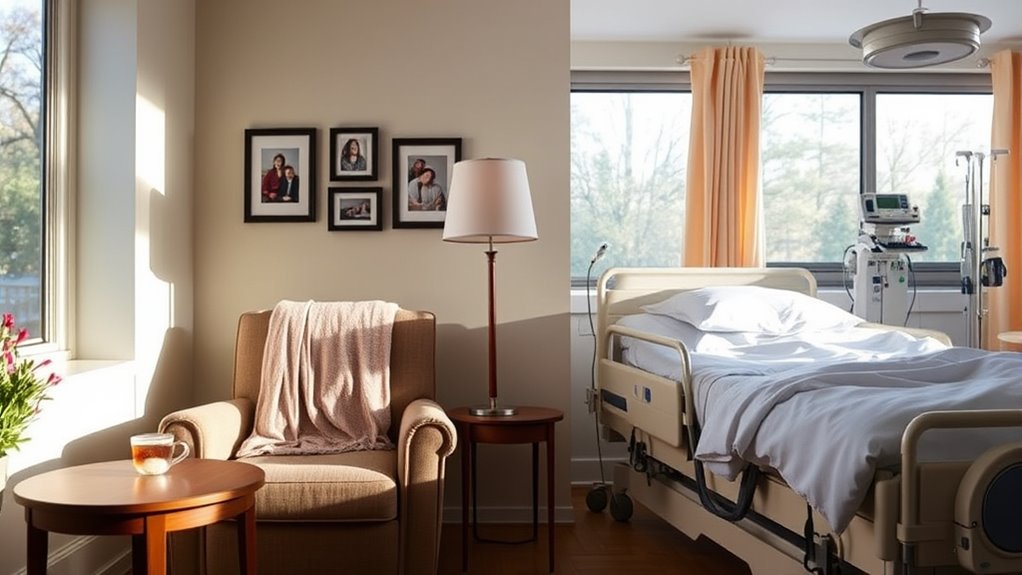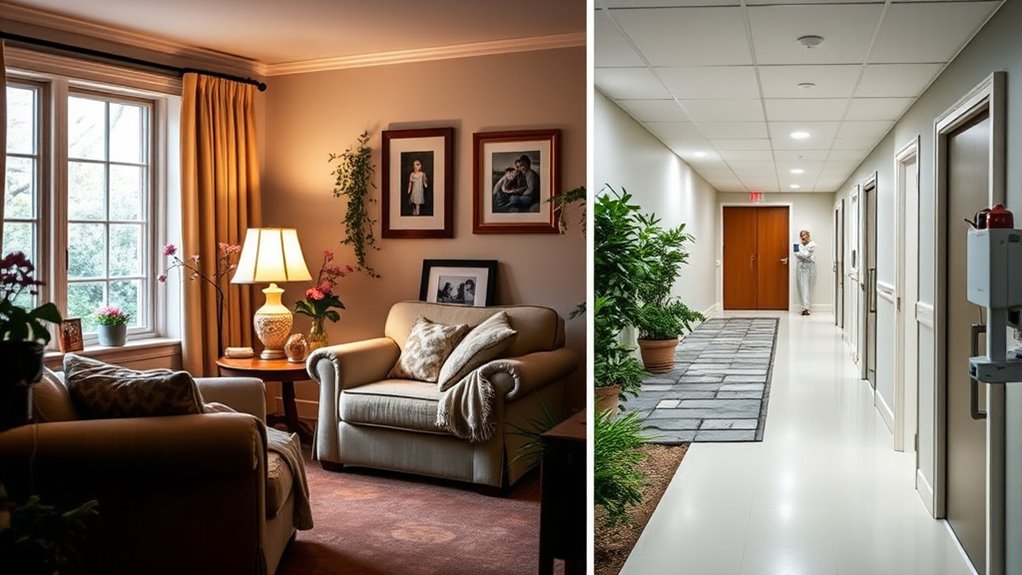Choosing between home and inpatient hospice depends on your loved one’s medical needs, emotional comfort, and caregiving resources. If they prefer familiar surroundings and manageable symptoms, home hospice offers personalized care with family involvement. But if symptoms become complex or require constant medical monitoring, inpatient hospice provides specialized support in a comfortable setting. Understanding these options helps you make the best decision for comfort and quality of life—more details can guide you toward the right choice.
Key Takeaways
- Consider the patient’s medical needs; complex symptoms may require inpatient care, while manageable symptoms suit home hospice.
- Evaluate available resources and caregiver support; home hospice demands active family involvement, whereas inpatient provides professional care.
- Prioritize comfort and familiarity; staying at home offers personalized routines and emotional security.
- Assess the need for advanced medical equipment and continuous monitoring, which are more accessible in inpatient settings.
- Consult healthcare professionals to weigh the benefits of emotional support, symptom management, and caregiver capacity for an informed choice.

Deciding between home hospice and inpatient hospice can be challenging, as both options aim to provide compassionate end-of-life care. Your choice depends on many factors, including your loved one’s medical needs, personal preferences, and the kind of environment that will bring the most comfort. When considering home hospice, you’re opting for a setting where your loved one can receive palliative care in the familiar surroundings of their home. This environment allows for personalized care, where routines are tailored to their needs, and family members can be actively involved in daily caregiving. Palliative care at home offers a holistic approach, focusing on managing symptoms like pain, nausea, or breathlessness while addressing emotional and psychological needs. Emotional support becomes especially indispensable here, as being in a familiar place provides comfort and a sense of security. You and your family can be present during important moments, helping to create meaningful memories even during difficult times.
On the other hand, inpatient hospice provides a specialized environment equipped to handle complex medical needs that might be challenging to manage at home. If your loved one’s symptoms become difficult to control or if they require frequent monitoring, inpatient care offers immediate access to skilled healthcare professionals around the clock. This setting guarantees that your loved one receives continuous medical attention and symptom management, which can be essential in the final stages of life. Inpatient hospice facilities often have dedicated staff trained to provide emotional support not only to patients but also to family members. This support can be invaluable when dealing with feelings of grief, fear, or uncertainty. The structured environment can also lessen the burden on family caregivers, who might feel overwhelmed managing complex symptoms or medical equipment at home.
Ultimately, your decision should consider what environment will best support your loved one’s comfort, dignity, and emotional well-being. If maintaining a sense of independence and familiarity is important, home hospice may be the right choice, especially if you have the necessary resources and support system. If your loved one’s medical needs are more complex or require intensive monitoring, inpatient hospice might be the safer, more suitable option. Remember, both options prioritize compassionate care, pain and symptom management, and emotional support. Whichever route you choose, make certain that your loved one’s comfort and dignity remain central, and don’t hesitate to seek guidance from healthcare professionals to make the most informed decision.
Frequently Asked Questions
How Do Insurance Policies Differ Between Home and Inpatient Hospice?
Your insurance coverage often differs between home and inpatient hospice. With home hospice, your policy generally covers medical supplies, medications, and nursing care at home, but there may be policy limitations on certain services. In inpatient hospice, coverage includes room, meals, and around-the-clock care in a facility, but some policies might have stricter limitations or require prior authorization. Check your specific policy to understand these differences.
Can Patients Switch Between Home and Inpatient Hospice Services?
Yes, you can switch between home and inpatient hospice services if your needs change. Healthcare providers offer changeover flexibility to accommodate care setting changes, ensuring your comfort and support. If you or your loved one requires more intensive care or wishes for a different environment, switching is possible. Discuss your preferences with your hospice team, who will guide you through the process and help coordinate the necessary arrangements.
What Are the Privacy Considerations for Each Hospice Type?
Of course, privacy is a breeze—or is it? When it comes to patient confidentiality and data security, home hospice offers the charm of familiar surroundings but may pose risks if family members access sensitive info. Inpatient hospice, with its professional staff, generally provides tighter controls and secure records. Either way, you’ll want safeguards in place to keep your personal details private, because nobody likes an unintended peek behind the curtain.
How Is Pain Management Tailored Differently in Home vs. Inpatient Hospice?
In home hospice, you receive personalized medication plans tailored to your comfort needs, often managed by your loved ones with guidance from hospice staff. In inpatient hospice, staff closely monitor and adjust pain management, providing immediate comfort measures. Both settings aim to keep you comfortable, but inpatient care offers more rapid response to symptoms, ensuring your pain is managed effectively through personalized medication adjustments and all-encompassing comfort measures.
Are Family Caregivers Trained Differently for Home Hospice Care?
Caregivers in home hospice receive specialized, simplified training tailored to home care needs. They’re taught techniques to tackle tasks like medication management, bedside bathing, and basic wound care. This targeted training boosts their confidence, comfort, and competence, empowering them to provide personalized, persistent support. By focusing on fundamental functions, caregivers gain the skills to handle home health hurdles, ensuring loved ones receive safe, sacred, and supportive care at home.
Conclusion
Choosing between home and inpatient hospice is like picking the perfect harbor for a voyage’s end. At home, you’re the captain steering familiar waters, surrounded by loved ones’ warmth. In inpatient care, you find a steady lighthouse guiding you through stormy seas with expert hands. Trust your heart’s compass to lead you to the harbor where peace and comfort await, ensuring your final journey is filled with dignity, love, and gentle light.









